¡HI! If you want to propose us a project, send a mail to info@albatian.com

+34 91 433 30 99 GET OUR NEWSLETTER
THANKS FOR NOTICING HIGH FOR OUR NEWSLETTER
¡HI! If you want to propose us a project, send a mail to info@albatian.com

+34 91 433 30 99 GET OUR NEWSLETTER
THANKS FOR NOTICING HIGH FOR OUR NEWSLETTER
-
COMPANY

COMPANY
ENTERPRISE SOLUTIONS BASED ON STRATEGY AND MANAGEMENT
-
SERVICES

SERVICES
New solutions aimed to accompany you on your challenges and improve your business
-
PRODUCTS

PRODUCTS
Tramsformers business models in a fast changing world
-
REFERENCES

REFERENCES
COMMITMENT TO THE SUCCESS OF OUR CUSTOMERS AND PARTNERS
-
PARTNERS

PARTNERS
STRATEGIC ALLIANCES TO INCREASE THE VALUE OF YOUR BUSINESS
- CONNECTIAN
- TRAINING EVENTS

TRANSFORMERS BUSINESS MODELS
IN A FAST CHANGING WORLD


DESIGN
APIA IS HIGHLY PARAMETERIZABLE, IT HAS TOOLS FOR THE DESIGN OF:
- Processes and Forms (associated to the tasks of the defined processes).
- Data entities used for processes and forms (including the definition of ABMs pfor the loading of data).
- Queries and reports (on-line and batch) using both the data used by the processes and the data used by external applications.
- Analytic models (cubes), indicators, and dashboards.
- Programmable business rules (java, java script, stored procedures, web services, views), integrated to the processes and forms.
- Exposure as services of processes, tasks, queries and business rules.
- Integration of services of third parties with the processes and forms (with no need of programming).
- Management of roles, work groups, organizational structure.
- Definition of calendars and terms of tasks and processes’ execution.
- Tasks’ lists and customized processes’ monitors.
- Automatic generation of the documentation which contains the graphics of processes and defined forms, and information about the processes, tasks and business rules.
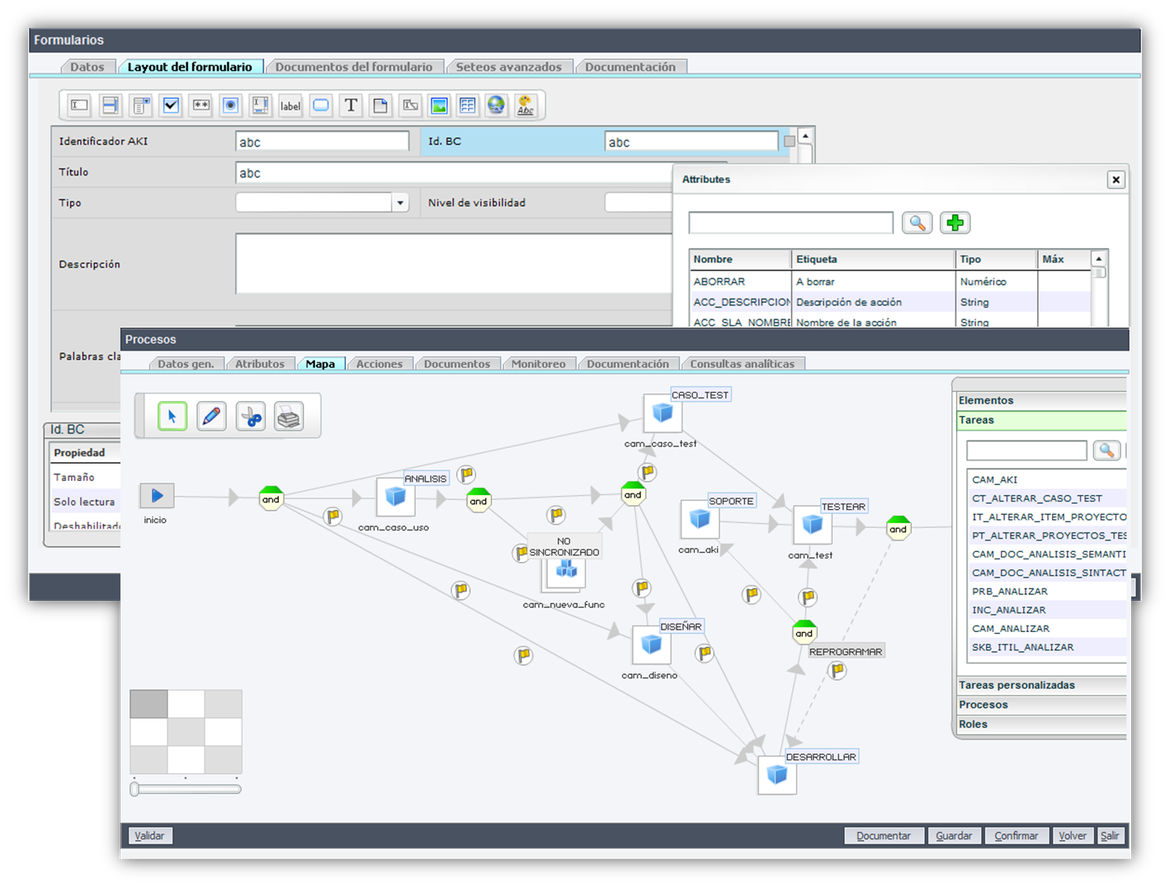
EXECUTION
APIA'S EXECUTION MODULE HAS:
- Customizable, intuitive and integrated execution environment, with a menu of options dependent on the connected user’s profile (two types of environment: classic and multi-window).
- Window of messages presented when logging in the application with the events relevant for the user (new assigned tasks, delayed acquired tasks, etc.).
- Work trays customizable by profile:
- Free tasks: Tasks directly assigned to the user or to some of the work groups to which he belongs.>
- My Tasks: Tasks acquired by the user (only he can work on them).
- Work summary: Graphic summary of the work tray’s content, grouped by processes, tasks and work groups.
- In the work trays the tasks are highlighted according to the processes’ priority, and to the expiry date of the defined execution terms.
- Users can work on the assigned tasks, complete them, save the work, acquire, release, delegate or submit them according to the organizational structure.
- Possibility of attaching documents in any point of the process, altering existing documents (versioning them) and signing them digitally.
- Start of new processes.
- Execution of queries and reports associated to the user’s profile.
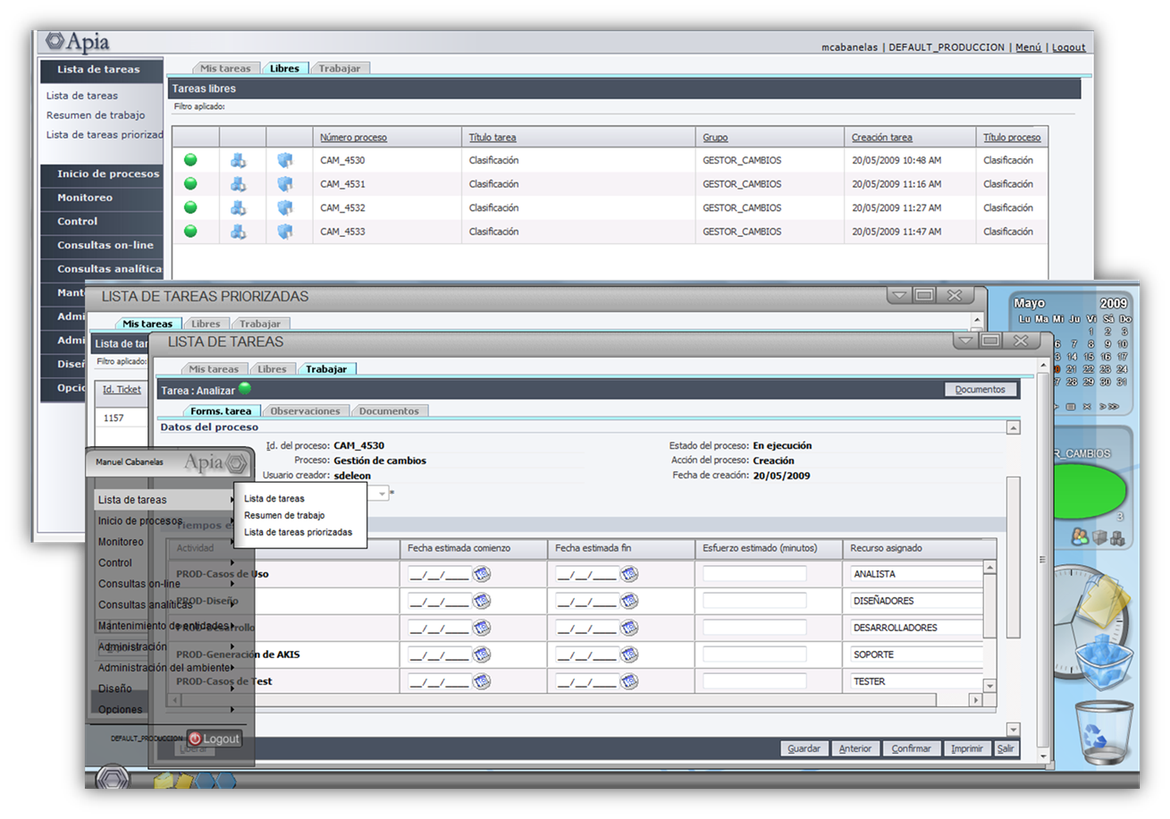
MONITORING
Contemporary markets are characterized by only one constant which is instability and fluctuations. This situation of uncertainty forces organizations to have tools which allow obtaining a global and updated vision of all the actions and processes which are developed daily.
Apia has monitoring and analysis modules created to offer either managers or business analysts, reports in real time which are necessary to be able to anticipate, react and adapt to the continuous changes caused by the market and by the company’s reality.
MONITORING AND CONTROL APIA´S MODULE HAS:
Monitoring and control modules have Processes and tasks’ monitors which allow acceding to the information associated to all the created processes (in graphic and tabular format) including:
- The user who created them and the date when they were created.
- If they have finished or they are in execution and the date when they were finished.
- If they were delayed or not.
- The data and documents associated to the process.
- The process’ tasks with information about:
- If they were already completed or they are in execution.
- The group to which they are assigned, and the user who has it assigned.
- The user and date when they were completed.
- If they were delayed or not.
- The data and documents with which the tasks was completed.
- Reassignment and release of tasks using the organizational structure.
- Administration of licences and substitutions.
- Cancel, suspend, finish, or return to a point of the process already executed (Rollback).
- Monitor of Documents (being able to search by content).
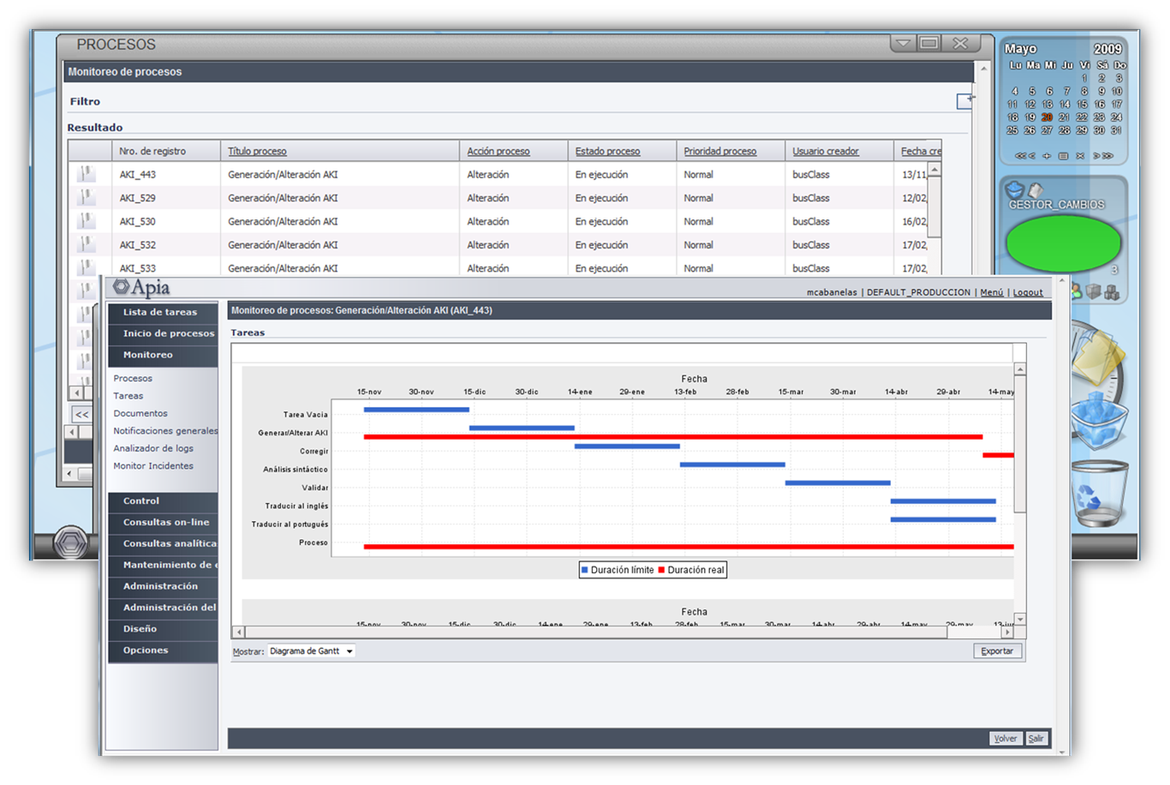
ANALYSIS (BI)
WITH REGARD TO THIS MODULE, APIA HAS
- Datawarehouse loaded in real time which contains the information used by the processes.
- Cubes and views by default included in the tool, which contain measures (amounts, execution average terms, etc.), and dimensions (processes, tasks, work groups, users, start and end dates, priority, etc.).
- Possibility of creating new views for the cubes by default in graphic and tabular format.
- Drill-down of the views until reaching the level of the involved processes.
- Exportation of the defined views (data and graphics) to pdf and excel.
- Tools for the creation of new cubes.
- Tools for the definition of management indicators.
- Tools for the generation of dashboards which contain: indicators, graphics, views, etc.
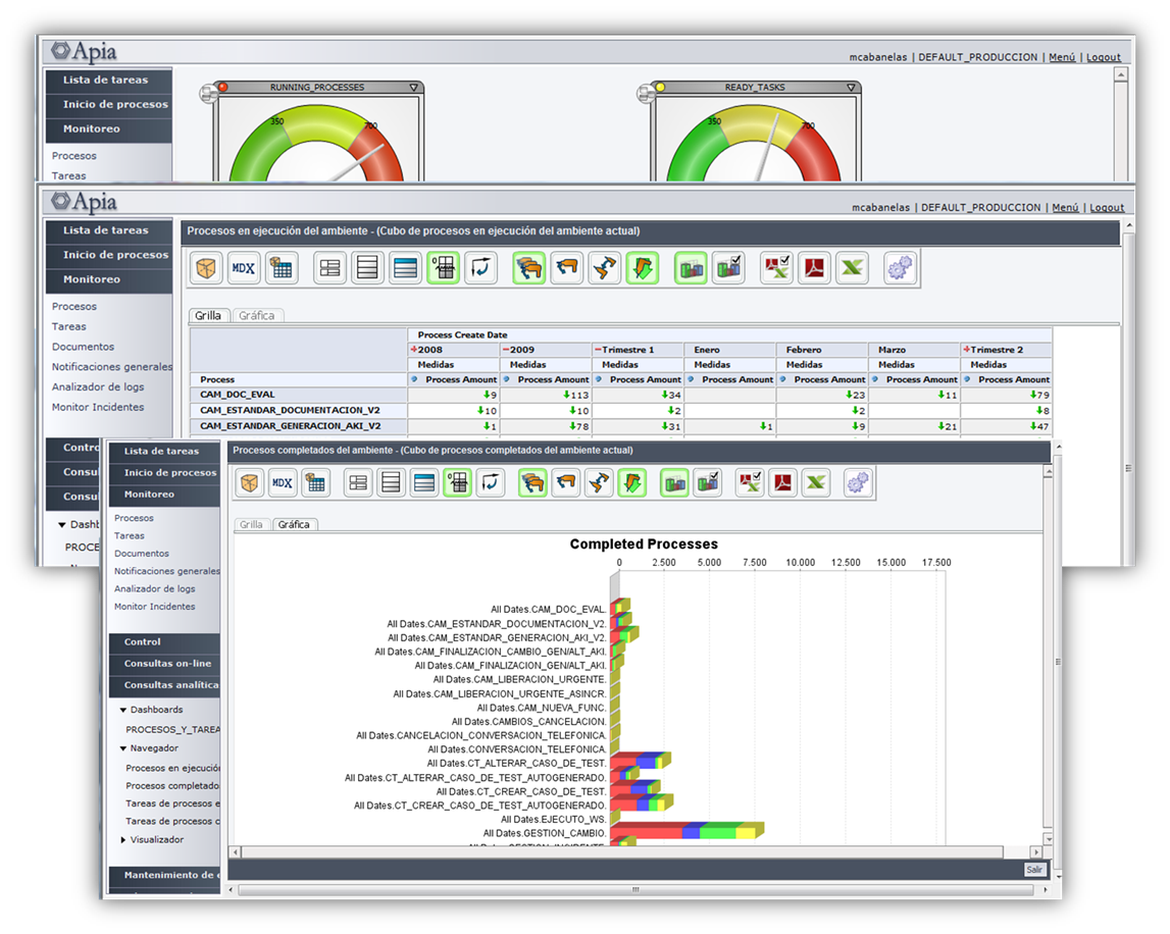
IT ADMINISTRATION
APIA HAS TOOLS TO:
- Manage environments, users (it is integrated with LDAP), passwords, profiles and work groups.
- Make new installations, install fixes, and do upgrades of versions.
- Migrate environments (in a complete way, or updating).
- Publish and depublish WebServices.
- Logs’ analyzer, which allows issuing reports with the system’s errors, number of calls and execution times for tasks, queries, interphases, etc.
- Monitor of activity in real time:
- It provides information about: consumption of CPU and memory, number of connections opened to the data base, etc.
- It allows defining SLAs associated to the execution of interphases, queries, tasks, etc., and monitoring the violations of those SLA.
- Issuing of statistic reports.
- Scheduler to schedule from batch executions.
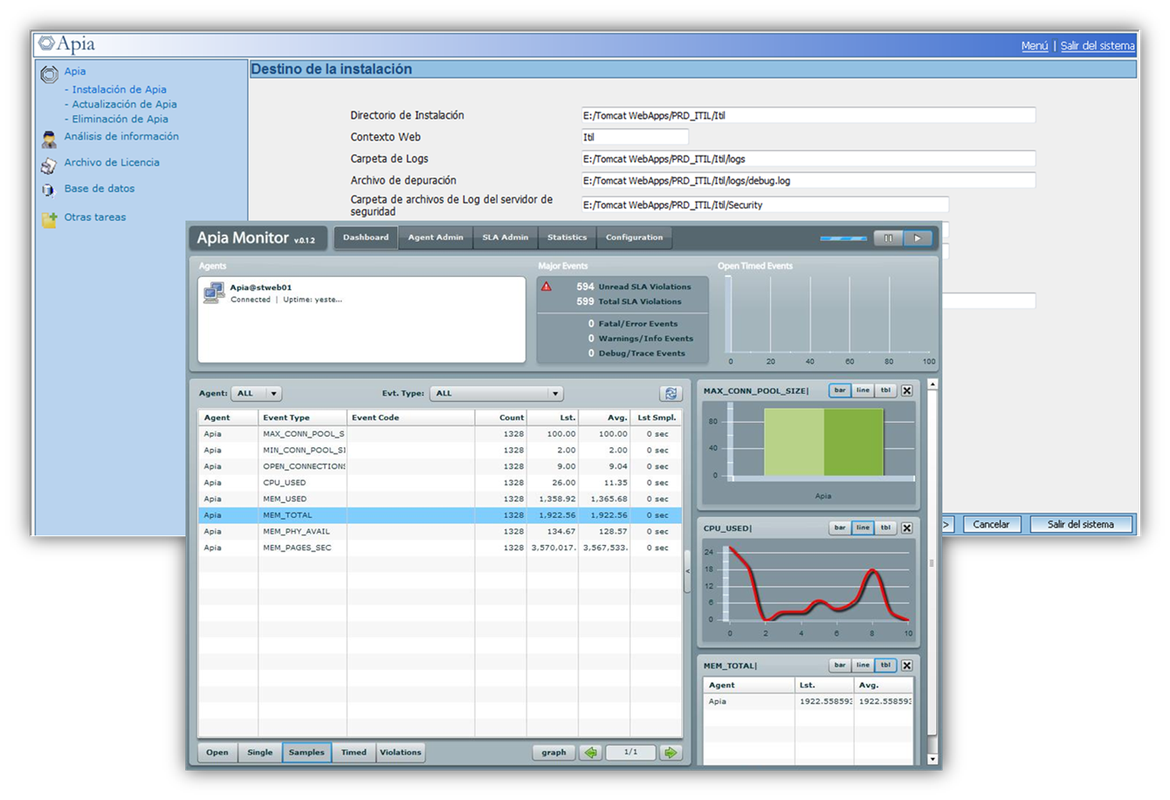
FOR MORE INFORMATION ON THIS PRODUCT
WRITE TO US AND HOW CAN YOU TELL YOUR COMPANY TO APPLY
Thank you for contacting us shortly process your request.






